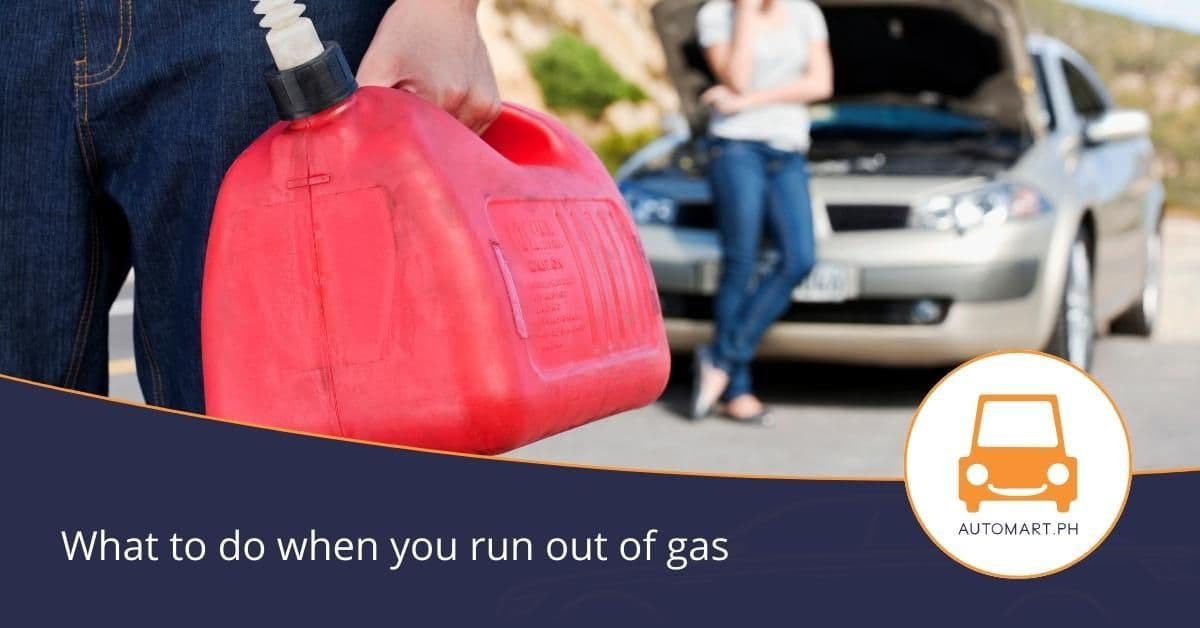
What to do when you run out of gas
Updated on December 18 2025
METRO MANILA, Updated August 1, 2022 – One of the biggest fears that every driver has is to run out of gas in the middle of the road.
At some point, you may find a vehicle stuck at the shoulder of the expressway because of an empty gas tank. This situation is one of the easiest things to avoid. But most drivers are somewhat inexperienced on how to handle this occurrence with a level head.
When traveling long distances, keeping your vehicle in good shape is necessary. Don’t overestimate (or underestimate) your gas mileage or else you might end up cutting it too close.
What happens when it hits empty?
Running out of gas doesn’t suddenly happen.
You will get a few warnings before the worst happens. For instance, your fuel gauge warning light can give you an early sign that your fuel level is running low.
But your car will "speak up" when you are about to run out of gas as you can experience the following:
Loss of power
The early sign of a near-empty tank is loss of engine power when ascending. Fuel starvation cannot accelerate while pressing the gas pedal.
Engine sputtering
Since not enough gas is flowing through the cylinder, the engine tends to emit unusual burping or hiccupping sounds, which is caused by too much air pressure.
Backfire
In older vehicles, running out of gas enables the car to produce a loud pop like a firework coming out of the tailpipe. That said, it means you're running out of gas.
Surging
A jerking sensation can be felt from behind the wheel as if your car is thrusting back and forth.
How far can your gas tank really go?
When your tank approaches near empty and your low fuel warning light comes on, it’s time to fill up.
If the gauge indicates the miles left before the car stalls, consider it your best guide. This instrument calculates your “average fuel consumption” based on your driving over some time.
Reserve
All cars come with reserve fuel tanks.
However, it varies from model to model. Subcompact cars typically have three liters, while executive sedans have about seven liters. Large SUVs can even carry up to 10 extra liters, depending on the manufacturer.
Keep in mind that the mileage left is just an estimate as it can significantly drop when sitting in traffic, climbing a steep grade or driving at high speed.
Empty, but not totally out
Sometimes, a car suffers from fuel starvation not because of an empty tank.
Another reason this happens is a clogged fuel filter or fuel pump. It’s pretty expensive to repair clogged fuel injectors than to buy a new filter. A clogged fuel filter may require a towing service, but replacing it at the side of the road is much easier.
Mind you, if the fuel pump is sucking from an empty tank, it’s pumping air and sediments that won’t make the car start. This is another reason why you shouldn't run on empty all the time.
Things to do when you're out of gas
When your car runs out of gas, it’s not only the inconvenience, but also the challenge of how you can cope with a dying engine.
That said, you’ll experience losing the hydraulic power of your brakes and steering, which means that braking and maneuvering will need additional effort. Here are the things to do when you’re cautioned that your car is running out of gas:
Pull over with hazard lights on
To be stranded on the road among fast-moving vehicles can be dangerous.
But you must stay calm when you have fuel problems happens. Navigate to the right shoulder or, if possible, exit the highway and find a parking lot or open space that is free of traffic.
Switch your hazard warning lights on to warn other motorists that your car is waiting for assistance.
Turn off the air-conditioner and sound system
Turning off the air-conditioner immediately can reduce engine stress and save fuel.
Doing this also shuts down the power-hungry cabin fan. A high-powered stereo plus charging portals are also fuel-consuming, so turning them off can save you gas.
Also, roll up the windows to reduce wind resistance before the tank gets emptied.
Call breakdown services for help
Dial for roadside assistance through your insurance company or local service.
Let them know you are stranded without gas. Let them the type of gas you need. Also, get in touch with a friend, a family member or a towing service.
Slow down immediately
Don’t speed up to get to the gas station quickly because the faster you accelerate, the more fuel you burn.
Studies reveal that for a vehicle to be fuel-efficient, an optimal speed of 55 to 70 km/h is recommended, especially you’re low on fuel.
Figure out your location
Take GPS coordinates from your smartphone. Your location is important to emergency response teams.
If all else fails
Push the car to the nearest gas station to refuel or walk to get a gas can.
Prepare yourself for a long walk to secure what you need and walk back to the direction where your car stalled.
In case you plan to buy gas, never leave valuables inside the vehicle.
When you have already refueled the car, you need to fire up the engine without adding more stress on the ignition, starter motor and battery. Gently press the accelerator to engage the fuel injectors quickly and turn the ignition.
Automart.PH offers a wide selection of used cars at great prices, ranging from compact cars to pick-up trucks, that suit your needs.
And if you’re looking for the finest used cars, check out Automart.PH Certified Used Vehicles. These are restored until they feel like new again. They also come with a three-day money-back guarantee and, for Gold Certified units, a one-year warranty.
Automart.PH Senior Content Creator VJ Bacungan contributed to this story.